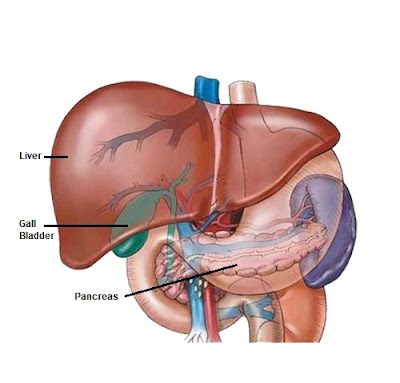The biliary system aka biliary tract or biliary tree refers to the liver, gall bladder (a muscular pouch) and bile ducts. They work together to make, store and secrete a green digestive juice and lubricant called bile. Specifically, the liver makes bile and the gall bladder stores it. The gall bladder is essentially the body's attempted 'insurance policy' to always have sufficient bile. Contractions of the gall bladder occurring when you eat trigger the gall bladder to secrete bile (out to the intestines). In fact, so focused on ensuring your body has sufficient bile, your body may even recycle bile that has reached the intestines to make more bile in the liver.
Liver
In fact, roughly every 6 minutes, all of the blood passes through the liver for detoxification.
The liver is the single largest detoxification organ in the body. It filters the blood. However, this 'blood purification' should be considered broadly to include the entire body. Specifically, the blood merely transports toxins to the liver to be expelled from all bodily tissues; including bones, ligaments, organs, skin, fat and so on.
In other words, the liver works to remove environmental pollutants like residual pesticides in your food, chemicals in pharmaceutical drugs and supplements, air borne pollutants and so on. The chemical toxins to be expelled are not only from the external environment but even those toxins produced very deeply in the body like damaged proteins that the cells created.
The liver releases those toxins into the small intestines (to be eventually expelled in the feces). However, as mentioned below, the liver uses its bile to transport these toxins away as quickly as possible.
Bile (aka Gall) & Its Functions
The main components of bile are cholesterol and bile salts. One of its main functions is to digest fat. It acts much like a dishwashing detergent on greasy dishes, ie it emulsifies any type of fat in food (including drinks, vegetables and nuts) so it can extract component vitamins (A, D, E and K).
Another function of this liquid is detoxification; ie to remove and eliminate any toxin (natural and otherwise). In short, a good flow of bile is good and therefore a noteworthy healthy objective. Practices like coffee enemas and liver and gall bladder flushes are done to this end (among other things, like colon cleansing).
Gallbladder Stones
A perfectly functioning biliary system does not produce gallstones. However, if your body does not produce sufficient bile, gallstones will develop. In short, gall stones signal that all is not well with your biliary system.
Gallstones form as a result of the precipitation (ie solidification) of one of several substances. There are different types of gallstones. For instance, cholesterol and crystals precipitate to form different types of gallstones, even in combination. Gallstones are more prevalent among women and people who are over 40 and overweight.
Gallstone Attacks and Signs & Symptoms of Gall Bladder Problems
Gallstones often occur without any awareness or pain. However, if gallstones get temporarily stuck inside a duct, this will cause sudden and sharp abdominal pain called gallstone attack aka gallbladder attack or biliary colic. Especially after eating fatty meals, this pain may accompany nausea, pain in the right shoulder and vomiting. A gallbladder attack usually lasts for several hours.
Outside of outright gallbladder attacks, signs and symptoms of problems associated with the gallbladder problems (like insufficient bile) include: bloating; headaches, especially on the right side (including migraines); nausea; lack of satisfaction after meals (due to poor absorption of nutrients from fats and food in general); cravings for fatty foods like fried food; cravings for sugar after meals (because since the bile helps regulate blood sugars; your sugar levels feel insufficient); dry itchy eyes; itchy skin; burping; liver spots (aka age spots); acid reflux; sneezing; depression and diminished stamina.
Causes & Triggers of Gallbladder Problems
- junk food, including processed wheat foods, especially when there are high amounts of both saturated fats and sugars
- protein isolates. In fact, protein isolates have even been linked with liver tumors. Beware, protein isolates are often found as an ingredient in foods marketed as being 'healthy'.
- estrogen, including birth control pills, hormone replacement therapy, pregnancy, ovulation, fibroids, estrogen-rich foods like soybean foods. Estrogen actually restricts the ducts.
- high levels of cortisol, ie the 'stress hormone'. Extended periods of stress depletes bile and, in turn, causes digestive problems
- lack of vegetables
- being out of sync with the circadian rhythm.
- alcohol
- a diet low in saturated fat that does not trigger the liver to produce sufficient bile. Saturated fats alone are not problematic. The challenge arises if they are combined with carbohydrates.
- a toxic physical environment, including what goes onto your body (like personal care products, cleaning chemicals and so on).
Long-term Effects of Gallbladder Problems
Gallstone attacks are known to lead to further problems in nearly 30% of gallstone cases. For instance, many of these cases develop:
- inflammation of the gallbladder
- inflammation of the pancreas
- thyroid problems.
CONTENT RELATED TO THE BILIARY SYSTEM
- Liver and gall bladder flush. A 'liver' detoxification process involves the entire body. After all, the liver's job involves detoxifying the entire body. Specifically, in addition to cleaning the blood, its job also includes detoxification of all the body's tissues, bones, ligaments and so on. When doing any cleansing program, a liver detoxification is very useful or even essential to release the additional burden on the liver and prevent re-absorption of toxins back into the body.
- If you have liver and gallbladder problems, sleep on your right side.
- Since the skin is a key elimination organ, its condition can often indicate the quality of liver function. For instance, skin conditions like acne and hives have been related to liver congestion.

No comments:
Post a Comment